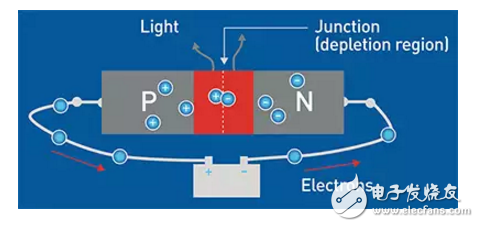
资料下载

照明应用中led结温的计算
照明应用中led结温的计算
操作LED超过制造商推荐的最高温度可以降低设备的效率和光输出,并可能导致过早失效。LED的热点被定义为形成二极管的p型和n型半导体之间的结。本文使用一个示例照明应用程序来说明如何计算LED的结温,并确定它是否有可能超过指定的上限。
LED结温的计算
一个LED通过将电荷载体(电子和空穴)重新连接到LED连接处,将电能转换成光(图1)。不幸的是,即使发光二极管相对有效,大约65至75%的电能消耗仍然产生热量,而不是光,提高芯片的温度。

Figure 1: Charge carriers combine at the junction of an LED to generate some light and a lot of heat.
But just how hot can a high-brightness LED get? Let‘s look at how to determine junction temperature using a simple calculation.
The maximum junction temperature (Tj) attained with a given power input is determined by three factors: ambient temperature, thermal resistance between the LED junction and its surroundings, and the power dissipated by the chip.¹
For ease of calculation, let’s assume an ambient temperature (Ta) of 23 degrees Celsius (°C)。 (Note that a comprehensive design calculation should consider the worst case scenario of the maximum ambient temperature that the LED will experience in normal operation.) Lower ambient temperatures will decrease the junction temperature and prolong the life of the LED. This makes LED lighting a good choice for certain applications, such as chilled food display cabinets.
声明:本文内容及配图由入驻作者撰写或者入驻合作网站授权转载。文章观点仅代表作者本人,不代表电子发烧友网立场。文章及其配图仅供工程师学习之用,如有内容侵权或者其他违规问题,请联系本站处理。 举报投诉
- 相关下载
- 相关文章







